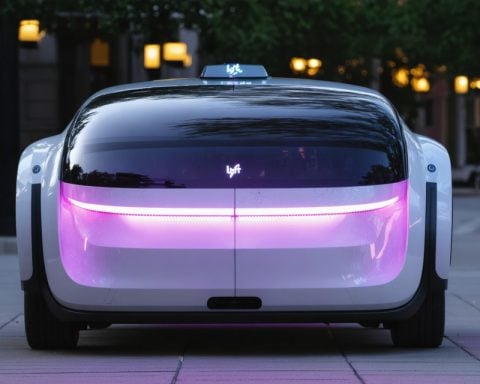- Rivian’s shares dropped due to a projected delivery downturn for 2025, raising future momentum concerns.
- Despite this, fourth-quarter results showed revenue growth to $1.73 billion and lower-than-expected losses.
- Key achievements include strong software and services revenue, enhanced by a profitable joint venture with Volkswagen.
- The company’s positive gross margin underscores operational efficiency and strategic partnerships.
- Investors are wary of a broader industry trend of slowing demand in the EV market.
- Rivian’s current successes highlight the importance of adaptability and diversified revenue streams.
- The company’s ability to balance immediate victories with a long-term vision is vital for its future role in sustainable transportation.
Rivian, the ambitious electric vehicle trailblazer, recently sent ripples through the market with an unexpected revelation. The company’s shares stumbled as news broke about a predicted downturn in deliveries for 2025, casting doubt on its future momentum. Yet, amidst this dark cloud, a striking achievement shone through.
Recent fourth-quarter results revealed Rivian’s revenue soaring to $1.73 billion, complemented by a slimmer-than-anticipated loss of $0.46 per share. This positive turnaround was largely driven by robust software and services revenue. The strategic joint venture with Volkswagen, a move that unlocked a “very high margin revenue stream,” played a pivotal role in propelling Rivian to a significant milestone: a positive gross margin.
However, the company’s optimistic earnings were overshadowed by its sobering 2025 outlook. The lingering anxiety stems not from its financial successes but from a broader industry trend. Investors were jolted by the reality of a sluggish demand landscape, sparking concerns about the EV market’s growth deceleration.
The scenario highlights the complexities within the electric vehicle arena. Rivian’s current triumphs in operational efficiency showcase the potential of strategic partnerships and diverse revenue streams. Yet, the looming uncertainty of future demand serves as a stark reminder of the challenges that lie ahead for companies in the rapidly evolving EV market.
Rivian’s journey underscores a critical lesson: In the world of electric vehicles, where innovation is key, adaptability is equally essential. As the company navigates these turbulent times, its ability to balance immediate victories with long-term vision will be crucial in determining its role in the future of sustainable transportation.
Will Rivian’s Strategic Moves Revolutionize the EV Market?
How-To Steps & Life Hacks for Navigating the EV Space
1. Invest in Software and Services: As Rivian’s revenue growth shows, software and services can be lucrative. EV manufacturers should explore offering subscription-based services or other cloud-based solutions to customers.
2. Strategic Partnerships: Form partnerships to diversify revenue streams, as demonstrated by Rivian’s collaboration with Volkswagen. Such alliances can provide access to new technologies and markets.
3. Adjust to Market Trends: Continuously analyze market data to adapt to changing demands and economic conditions, just as Rivian must adapt to the projected 2025 downturn.
Real-World Use Cases
– Fleet Management: Rivian’s vehicles can be utilized for commercial fleets, taking advantage of their technology and durability for deliveries and logistics.
– Off-Road Adventures: With their impressive specifications, Rivian’s trucks and SUVs are perfect for outdoor enthusiasts looking for eco-friendly ways to explore nature.
Market Forecasts & Industry Trends
– Growing Competition and Market Share: With brands like Tesla, Ford, and GM investing heavily in EV technology, Rivian will face intense competition. Deloitte forecasts the EV market to account for 32% of the total vehicle market by 2030.
– Sustainability Trends: Consumers are increasingly eco-conscious, which should drive demand for sustainable transport, positioning Rivian as a key player if it can weather short-term downturns.
Reviews & Comparisons
– Rivian vs. Tesla: Rivian offers robust off-road capabilities, differentiating it from Tesla’s more street-oriented models. However, Tesla’s established infrastructure and loyal customer base present significant challenges.
Controversies & Limitations
– Production Capacity: Like many EV companies, Rivian faces production ramp-up issues, impacting delivery forecasts.
– Price Points: Rivian’s vehicles are priced at a premium, which may limit its market to affluent consumers.
Features, Specs & Pricing
– R1T Truck: Starts around $70,000, boasts a range of over 300 miles, and offers unique features like the ‘Gear Tunnel’ for storage.
– R1S SUV: Similar pricing and technology to the R1T, but designed for family travel and off-road capability.
Security & Sustainability
– Battery Recycling: Rivian’s commitment to sustainability includes plans for battery recycling initiatives to promote eco-friendly practices.
Insights & Predictions
– Supply Chain Innovations: Expect Rivian to innovate in supply chain logistics to address potential production bottlenecks.
– Adaptation to Autonomous Driving: As the industry moves towards autonomous technology, Rivian will likely focus on integrating these features.
Tutorials & Compatibility
– EV Maintenance Tips: Routine software updates are crucial for EV longevity. Owners should also routinely check tire pressure and brake systems.
Pros & Cons Overview
Pros:
– Innovative designs with strong off-road capabilities.
– Well-regarded software and service offerings.
Cons:
– Higher price points can limit market appeal.
– Production and delivery delays may curb momentum.
Actionable Recommendations
– Focus on Diversification: Continue expanding non-vehicle revenue streams to mitigate risks from EV market fluctuations.
– Customer Engagement: Enhance customer engagement through loyalty programs and user feedback loops.
– Cost Efficiency: Explore ways to reduce production costs to make vehicles more affordable.
Readers interested in tracking the latest in electric vehicle innovation and sustainable transportation should visit the Rivian website. Stay informed on trends and innovations in the EV industry to make smart investments and choices.

















